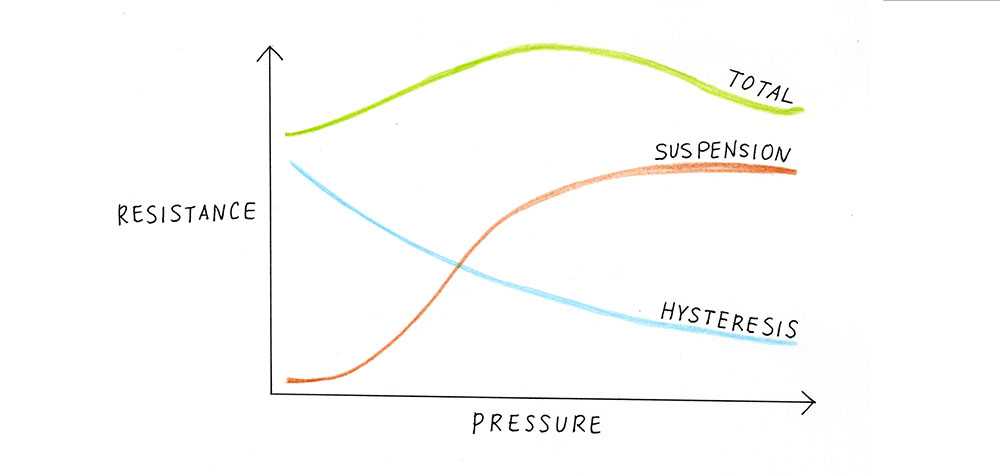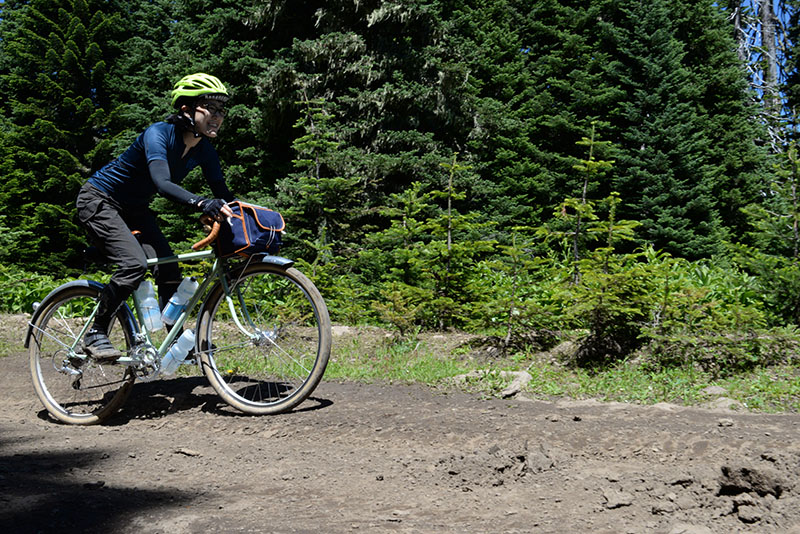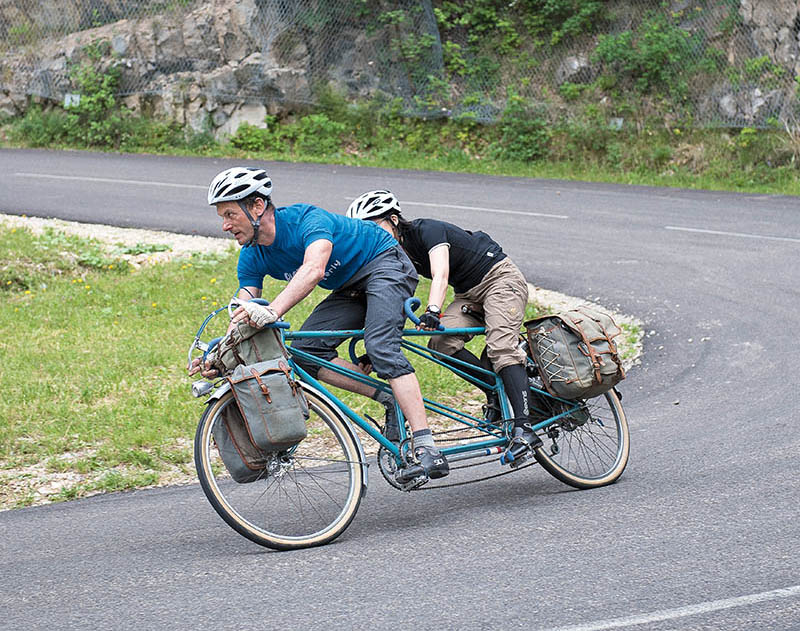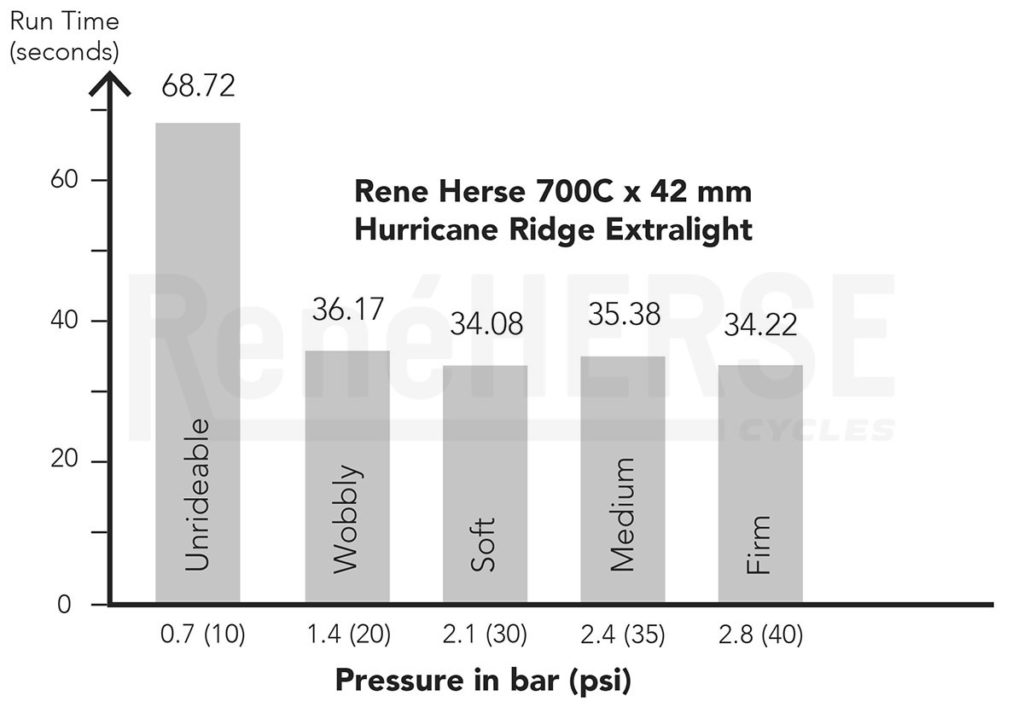Tire Pressure and Performance
When I was preparing my FKT ride over the notoriously rough gravel of the Oregon Outback last year, I needed to figure out what tire pressure to run. I looked at some online tire pressure calculators. One suggested to run my 54 mm-wide tires at 16 psi (1.1 bar) – which from experience is too low to even be rideable, at least with supple high-performance tires. Another calculator gave a value that was almost twice that – higher than I’d run even on smooth pavement. Why such wildly different values? The simple fact is that most current calculators work great in the middle of the range – average male gravel racers on 38 or 42 mm tires – but their datasets are not detailed enough to create reliable tire pressure recommendations for tires that are much wider and riders who are heavier or lighter than average.
Talking to the engineers who developed these calculators, it became clear that they intended their work as a “good starting point,” as one put it, to replace the old advice of inflating your tires to the max. pressure shown on the sidewall. For that purpose, the calculators are a great step in the right direction. They make no claim that the values they give actually have the lowest rolling resistance – simply because of a lack of data.
That got me thinking: We actually have data from hundreds of tire tests. We’ve tested the rolling resistance of tires between 20 and 55 mm wide, with different methodologies (rolldowns and power measurements). We’ve been testing tires for more than 15 years, ever since we found that higher pressures don’t make tires roll faster. That was the start of the All-Road Bike Revolution that has since swept over the bike world. Even professional racers no longer run pencil-thin tires, nor do they inflate their tires to 120 psi (8 bar) or more. So what pressure should we run?
There are many factors that determine the ‘right’ tire pressure for you. Only you know what feel you want from your bike… So we decided to focus on the pressure that gives you the lowest rolling resistance. Our testing has shown that – at least on smooth pavement – supple high-performance tires roll fastest at two distinct pressures: a relatively high pressure that provides a firm feel to the bike, and a low pressure that optimizes comfort.
Here is a typical racing tire, the 25 mm Vittoria Open CX Corsa—their top-of-the-line tire at the time. We measured the power it takes to ride at a speed of 27.9 km/h. (The test was done a few years ago, but there’s nothing to suggest that the latest models behave differently.) What you see is that the tires are fastest at either a relatively soft 5.5-6.0 bar (80-87 psi) or a very firm 7.3-8.2 bar (106-120 psi). At ‘medium’ pressures, they are actually slower than at lower or higher pressures. Those differences are statistically significant. The differences aren’t huge, but 10 watts is worth thinking about if you’re trying to win a race or complete a randonneur brevet within the time limit.
The same is true for 42 mm Rene Herse dual-purpose knobbies, tested in a roll-down test. The tires are faster at 2.1 bar (30 psi) and 2.8 bar (40 psi) than in between. The differences between ‘soft’ and ‘medium’ and between ‘medium’ and ‘firm’ are statistically significant. (The roll-down times translate into a speed difference of about 0.1-0.2 km/h, depending on how fast you ride.)

Why are there two optimum tire pressures? Tires affect rolling resistance in two different ways, as shown in the conceptual graph above:
- Hysteresis: The tire flexes at the bottom as it rolls on the road. Flexing the tire’s rubber takes energy. At low pressure, the tire deforms more, so it has more resistance (blue graph).
- Suspension Losses: Vibrations cause friction in bike and rider. This friction turns energy into heat and slow the bike down. Higher pressure means more vibration, hence higher suspension losses (red graph).
These two factors—hysteretic losses and suspension losses—are not linear. As you increase the pressure, you quickly get more vibration—the red line goes up immediately—but tire flex decreases only gradually—the blue line goes down slowly. At ‘medium’ pressures, the total resistance (green graph) is higher. As pressure increases further, the tire flexes less, but vibrations don’t increase much any longer—so you get lower resistance again.
You can optimize your rolling resistance in two ways:
- A ‘soft’ pressure for rides on rough roads or for a more comfortable ride.
- A ‘firm’ pressure if you like your bike to have a firm feel.
- Either pressure will optimize your speed by reducing rolling resistance to a minimum.
Obviously, the pressure with the lowest rolling resistance depends on your weight. How can we find the correct values for ‘soft’ and ‘firm’ pressures for your bike?

Bike tech expert and Bicycle Quarterly contributor Frank Berto measured tire deformation for dozens of tires. His charts show how tires behave at different pressures and loads. Berto’s data allows us to translate our performance tests into graphs that work for riders with different weights. That’s perhaps the biggest improvement over other pressure calculators: It works reliably, not just for our testers, but also riders with very different weights.

We’ve also tested our pressure calculator in the field. Natsuko (who’s at the light end of the spectrum) has tested the pressure calculator (above)…

… and we’ve also used the results on our tandem. This on-the-road testing gives us confidence across the entire range of rider weights. We’ve summarized all this data in two graphs, which allow riders to find the ‘firm’ and ‘soft’ pressures for their tire width and weight.


The graphs and back story were published in Bicycle Quarterly 78. To make it easy to find the right tire pressure, we’ve translated this data into an online tire pressure calculator.

Not only does this calculator optimize your tire pressure for the lowest rolling resistance, it also provides reliable results for everybody, regardless of weight. It’s also the first calculator for supple high-performance tires. Like all calculators, it’s intended as a starting point for figuring out which pressure works best for you, your bike and the terrain you ride.
Here’s a brief FAQ with additional information:
Why no tires narrower than 25 mm? We’re not including very narrow and extremely wide tires, nor extreme rider weights. The reason is simple: The calculator is based on actual performance measurements, and we just don’t have enough data for reliable predictions that far out. We’re working on expanding the range of the calculator, both with respect to tire sizes and rider weights.
Why doesn’t rim width factor into the calculation? Rim width doesn’t change our tire pressure recommendations.The idea that wider rims support the tire better and thus allow running lower pressures seems to make sense. However, once the sidewall deflects as the tire hits a bump, it bows outward more and more. No longer vertical, the tire sidewall cannot hold up the weight of bike-and-rider any longer. With wider rims, tire collapse happens more suddenly and dramatically, so you need an extra margin of safety. Read more about this here.
Is the pressure the same regardless of wheel size? Our testing has shown that the tire cross-section, and not the wheel size, determines how fast a tire rolls.
What about stiffer tires? Stiff sidewalls will always make a tire slower, and optimizing tire pressure becomes more complicated. On the one hand, these tires are stiffer, so you can run lower pressures. On the other hand, they consume much more energy as they flex, so stiff tires tend to roll faster at higher pressures. In the end, trying to optimize slow tires will never approach the speed (and comfort) you get with a set of supple high-performance tires.
I’m running lower pressures than you recommend. The calculator is designed to optimize your speed on pavement and smooth gravel. On very rough surfaces, lower pressures will improve comfort and speed. On the ultra-bumpy terrain of the Oregon Outback, I ran my tires at 19 psi, even though the calculator suggests 26 psi (soft) and 32 psi (firm). However, lower pressures will stress the tire casing more. In extreme cases, individual threads in the casing can break. Ultra-low pressure can also cause the tire to collapse during hard cornering, out-of-the-saddle sprints, or hard braking. Use ultra-low pressures at your own risk!
Why doesn’t riding style factor into the recommendations? Our calculator gives you the pressure with the lowest rolling resistance. That is independent of your riding style. What pressure you actually run depends on other factors like how you want your bike to feel – factors that only you can figure out through trial and error.
Don’t sweat it! Optimized pressure will make your bike a little faster and more comfortable, but the difference isn’t huge. You won’t get dropped by your friends because you’re running your tires at too high pressures. More important than tire pressure is choosing supple tires that offer both more speed and more comfort than stiff tires.
Like all science, our understanding of how tire pressure affects performance is evolving. As we do more tests and studies, we’ll refine this knowledge further. In its current form, the calculator is a big step forward from what we’ve had before: With the right pressure, your bike will be more comfortable, faster and safer.
Click here to use the Rene Herse Tire Pressure Calculator. (There’s also a link in the top menu on our home page.)





